Funded articles
- Page Path
-
- HOME
- BROWSE ARTICLES
- Funded articles
- Funded articles
-
- National Research Foundation of Korea (36)
- Ministry of Science and ICT (20)
- Hamadan University of Medical Sciences (12)
- Ministry of Education (8)
- Chungnam National University (5)
- Korea Centers for Disease Control and Prevention (5)
- Korean Pediatric Society (5)
- Soonchunhyang University (5)
- Ministry of Health and Welfare (4)
- Faculty of Medicine, Prince of Songkla University (3)
- Korea Health Industry Development Institute (3)
- Ministry of Environment (3)
- Ministry of Science, ICT and Future Planning (3)
- China Medical University Hospital (2)
- Chonnam National University (2)
- Chulalongkorn University (2)
- Eulji University (2)
- Faculty of Medicine Ramathibodi Hospital (2)
- Faculty of Medicine, Universitas Islam Indonesia (2)
- Gyeongsang National University (2)
- Hanyang University (2)
- Inha University (2)
- Korea Disease Control and Prevention Agency (2)
- Korea National Institute of Health (2)
- National Institutes of Health (2)
- National Science and Technology Council (2)
- Pusan National University (2)
- Tehran University of Medical Sciences and Health Services (2)
- Arak University of Medical Sciences (1)
- Bill and Melinda Gates Foundation (1)
- Cairo University (1)
- Center for Allergy, Immunology, and Microbiome (A.I.M.), China Medical University Hospital (1)
- Chonnam National University Hospital (1)
- Chung-Ang University (1)
- Consejo Nacional de Ciencia y Tecnología (1)
- Coordenação de Aperfeiçoamento de Pessoal de Nível Superior (1)
- Council of Scientific and Industrial Research (1)
- Duhok General Directorate of Health (1)
- Durham, North Carolina (1)
- e Korea Disease Control and Prevention Agency (1)
- Environmental Health Center for Hazardous Chemical Exposure (1)
- European Commission-European Research Executive Agency (1)
- Faculty of Medicine, Chulalongkorn University (1)
- Faculty of Medicine, Naresuan University, Phitsanulok, Thailand (1)
- Faculty of Medicine, Siriraj Hospital, Mahidol University (1)
- Faculty of Medicine, South Valley University (1)
- Fuzhou, Fujian, P.R.C (1)
- Genetics Service Unit (1)
- Gyeongsang National University Hospital (1)
- Hamadan University (1)
- Hankuk University of Foreign Studies (1)
- ICMR MD/MS Thesis Research Grant (1)
- Ilsung Research Award of Korean Academy Pediatric Allergy and Respiratory Disease (1)
- Indonesia Endowment Fund for Education (1)
- Indonesian Ministry of Education, Culture, Research, and Technology (1)
- Inha University Hospital (1)
- Inje University (1)
- Institute for Information and Communications Technology Planning and Evaluation (1)
- Institute of Information & Communications Technology Planning & Evaluation (1)
- Institute of Medical Science, Daegu Catholic University (1)
- JSPS KAKENHI (1)
- Kangwon National University (1)
- Kementerian Riset, Teknologi dan Pendidikan Tinggi (1)
- Khon Kaen University (1)
- Korea Childhood Leukemia Foundation (1)
- Korea Environmental Industry and Technology Insitute (1)
- Korea Environmental Industry and Technology Institute (1)
- Korea Institute of Radiological and Medical Sciences (1)
- Korea University (1)
- Korea University Anam Hospital (1)
- Korean Academy of Pediatric Allergy and Respiratory Disease (1)
- Korean Society of Breastfeeding Medicine (1)
- Kunhee Lee Child Cancer & Rare Disease Project (1)
- Kurdistan University of Medical Science (1)
- Kyung Hee University (1)
- Kyungpook National University Hospital (1)
- Luzhou Municipal People’s Government-Southwest Medical University Science and Technology strategic cooperation (1)
- Manipal Academy of Higher Education (1)
- Manipal Research grant (1)
- Ministry of Education, Culture, Sports, Science, and Technology (1)
- Ministry of Finance of Indonesia (1)
- Ministry of Health, Labour and Welfare (1)
- Ministry of Higher Education and Science of the Republic of Kazakhstan (1)
- Ministry of Science and Technology (1)
- Ministry of Science, Information and Communication Technology, and Future Planning (1)
- Mundipharma Pharmaceutical Sdn. Bhd (1)
- Namseoul University (1)
- National Cancer Center (1)
- National Center for Child Health and Development (1)
- National Center for Mental Health (1)
- National Health Insurance Ilsan Hospital (1)
- National Health Insurance Service Ilsan Hospital (1)
- National Institute of Health (1)
- National Institute of Medical Research Development (1)
- National IT Industry Promotion Agency (1)
- Navajbhai Ratan Tata trust - Health (1)
- Nazarbayev University (1)
- PEER/USAID (1)
- Pohang University of Science and Technology (1)
- Probiotics International Ltd (1)
- Pusan National University Hospital (1)
- Pusan National University School of Medicine and Biomedical Research Institute (1)
- Pusan National University Yangsan Hospital (1)
- Ramathibodi Research Fund (1)
- Ratchadapisek Sompoch Endowment Fund (1)
- Research of Korea Disease Control and Prevention Agency (1)
- Samsung Medical Center (1)
- São Paulo Research Foundation (1)
- Seoul National University (1)
- Seoul National University Bundang Hospital (1)
- Seoul National University Hospital (1)
- Severance Children’s Hospital (1)
- Severance Hospital Research Fund for Clinical Excellence (1)
- Sichuan Science and Technology Program (1)
- Siriraj Research Development Fund (1)
- SNUH Lee Kun-Hee Child Cancer & Rare Disease Project (1)
- Soonchunhyang University Research Fund (1)
- Taipei Medical University (1)
- Taiwan Ministry of Health and Welfare Clinical Trial Center (1)
- Tehran University of Medical Sciences (1)
- Thailand Science Research and Innovation Fund Chulalongkorn University (1)
- The Health System Research Institute, Ministry of Public Health (1)
- The Royal College of Pediatricians of Thailand (1)
- Tri-Service General Hospital (1)
- Union Grants Commission (1)
- Universitas Indonesia (1)
- Universiti Teknologi MARA (1)
- Uttarakhand State Council for Science and Technology (1)
- WHO-Regional office for South-East Asia (1)
- WPLab, Inc. (1)
- Yonsei University College of Medicine (1)
- Zeist Foundation (1)
- Zuoying Armed Forces General Hospital (1)
- Review Article
- Allergy
- Management of patients with allergic diseases in the era of COVID-19
- Eun Lee
- Clin Exp Pediatr. 2022;65(11):529-535. Published online September 23, 2022
-
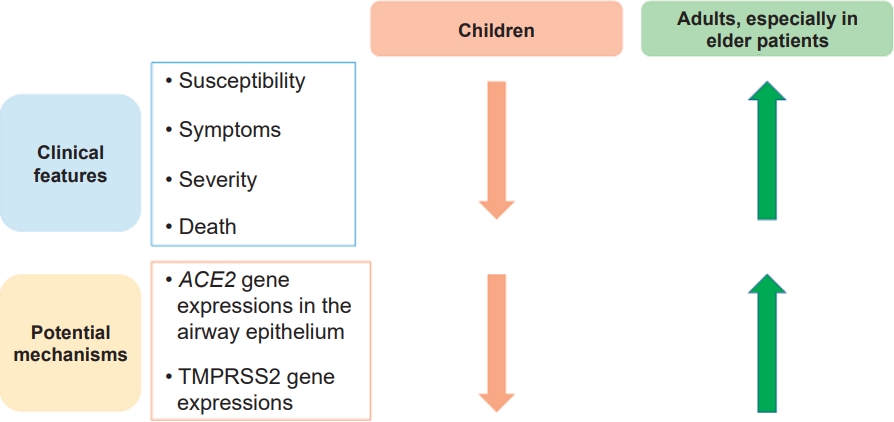
In the early days of the coronavirus disease 2019 (COVID-19) pandemic, allergic diseases, especially asthma, were considered to be risk factors for severe COVID-19 infection, hospitalization, and death. These concerns stemmed from the idea that individuals with allergic diseases are generally more susceptible to respiratory virus infections, which are major causes of exacerbation of allergic diseases. However, epidemiologic data with...
- Letter to the Editor
- Cardiology
- Early prophylaxis of cardiomyopathy with beta-blockers and angiotensin receptor blockers in patients with Duchenne muscular dystrophy
- Heirim Lee, Jinyoung Song, I-Seok Kang, June Huh, Jin A Yoon, Yong Beom Shin
- Clin Exp Pediatr. 2022;65(10):507-509. Published online August 22, 2022
-
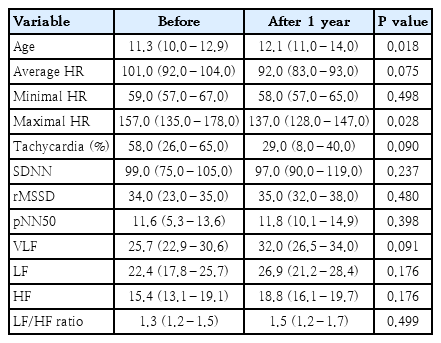
- Original Article
- Neonatology (Perinatology)
- Mediation effect of cord blood cortisol levels between maternal prepregnancy body mass index and birth weight: a hospital-based cross-sectional study
- Nisanth Selvam, Jayashree K, Prasanna Mithra
- Clin Exp Pediatr. 2022;65(10):500-506. Published online July 29, 2022
-

Question: What is the association between cord blood cortisol and maternal weight, birth weight, and cord blood lipid profile?
Finding: Cord blood cortisol levels did not influence the relationship between maternal weight changes or birth weight. Maternal weight changes, birth weight, and cortisol levels altered the cord blood lipid profile.
Meaning: Our findings may aid United Nations Sustainable Development Goal 3 (Good Health and Well-Being) achievement by 2030.
- Review Article
- Oncology
- Application of 3-dimensional printing implants for bone tumors
- Jong Woong Park, Hyun Guy Kang
- Clin Exp Pediatr. 2022;65(10):476-482. Published online December 23, 2021
-

∙ The application of 3-dimensional (3D) printing in orthopedic oncology is summarized into bone and tumor modeling, patient-specific instruments (PSIs), custom-made implants, and tissue engineering.
∙ The 3D-printed customized implant is the most central application, while modeling and PSI often play adjunct roles.
∙ Short-term surgical outcomes of custom-made 3D-printed implants are promising.
- Original Article
- Other
- Plastic bottle feeding produces changes in biochemical parameters in human infants – A pilot study
- Mahendra K. Pant, Abul. H. Ahmad, Manisha Naithani, Jayanti Pant
- Clin Exp Pediatr. 2022;65(9):459-465. Published online May 19, 2022
-

Question: Plastic feeding bottles are used commonly to feed infants who cannot be breastfeed. Does plastic bottle feeding produce biochemical changes in infants?
Finding: The plastic bottles leach out endocrine disruptors and affects bodily functions in terms of biochemical alterations like increased blood urea, raised creatine-kinase–MB levels, and altered lipid profile in infants exposed to bottle feeding.
Meaning: Plastic bottles feeding alters bodily functions in infants.
- Cardiology
- Early myocardial functional abnormalities in primary dyslipidemia: clinical and echocardiographic observations in young children from a highly consanguineous population
- Nehal M. El-koofy, Aya M. Fattouh, Areef Ramadan, Mohamed A. Elmonem, Dina H. Hamed
- Clin Exp Pediatr. 2022;65(8):410-416. Published online December 8, 2021
-
In children with primary dyslipidemia, functional myocardial abnormalities can occur at young age, including diastolic functional impairment of both ventricles and narrowing of the aortic valve and the sinus of Valsalva. Echocardiographic evaluations of high-risk children may be as important as biochemical evaluations.
- Review Article
- Other
- Epidemiology of pediatric fractures before versus during the coronavirus disease 2019 pandemic
- Chi Hoon Oh, Siyeong Yoon, Kyung Rae Ko, Young Woo Kwon, Kyeong Mi Kim, Hyun Seo Park, Hogyeong Kang, Inseok Jang, Soonchul Lee
- Clin Exp Pediatr. 2022;65(7):330-336. Published online June 3, 2022
-

∙ The novel coronavirus disease 2019 (COVID-19) was first reported in December 2019 as a cluster outbreak in Wuhan, since then, national lockdowns have included school closures, stay-at-home orders.
∙ The characteristics of adolescent fractures were often related to physical activity such as sports-related injury.
∙ During the COVID-19 pandemic, both in the East and the West, the incidence of fractures in children and adolescents is showing a decreasing trend worldwide.
∙ Fractures in children and adolescents were significantly reduced in the proportion of relatively low-energy damage, and the incidence of fractures in adolescents with greater activity compared to children was reduced.
∙ If COVID-19 pandemic ends, normal academic and sports activities increase due to the easing of lockdown policies, the number of trauma patients related to increased activity may increase rapidly, and clinics should prepare for this change.
- Original Article
- Endocrinology
- Effects of probiotics combined with dietary and lifestyle modification on clinical, biochemical, and radiological parameters in obese children with nonalcoholic fatty liver disease/nonalcoholic steatohepatitis: a randomized clinical trial
- Thushara Rodrigo, Samaranayake Dulani, Sumudu Nimali Seneviratne, Arjuna P. De Silva, Jerad Fernando, H. Janaka De Silva, Jayasekera , V. Pujitha Wickramasinghe
- Clin Exp Pediatr. 2022;65(6):304-311. Published online November 11, 2021
-
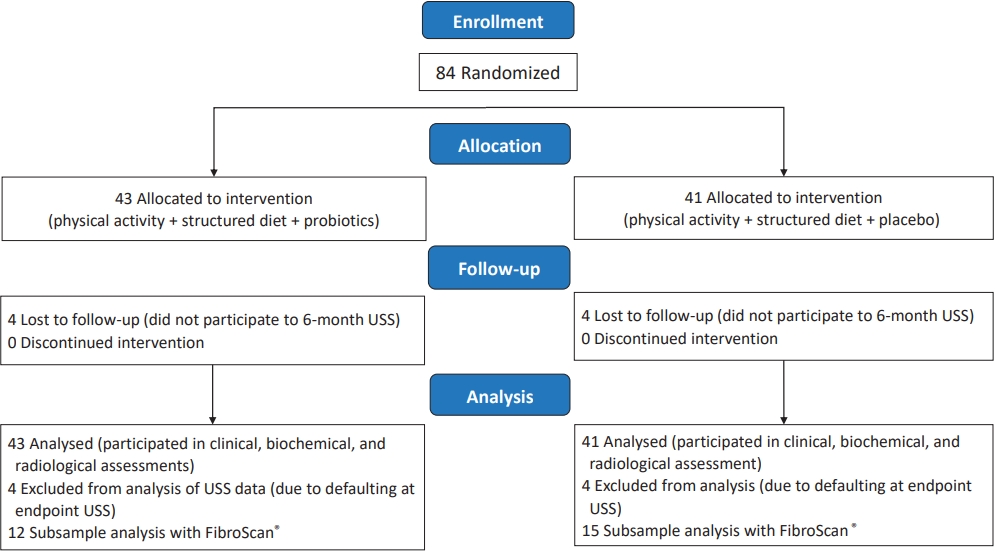
Question: Could probiotics be used as a therapeutic modality in nonalcoholic fatty liver disease/nonalcoholic steatohepatitis?
Finding: There seem no added advantages over lifestyle modifications compared to Probiotics.
Meaning: There does not seem to be an advantage of probiotics over lifestyle modifications in improving obesity-associated metabolic derangement in children.
- Review Article
- Endocrinology
- Pediatric hypertension based on Japanese Society of Hypertension Guidelines (JSH 2019) with actual school blood pressure screening data in Japan
- Toru Kikuchi
- Clin Exp Pediatr. 2022;65(6):283-290. Published online November 26, 2021
-
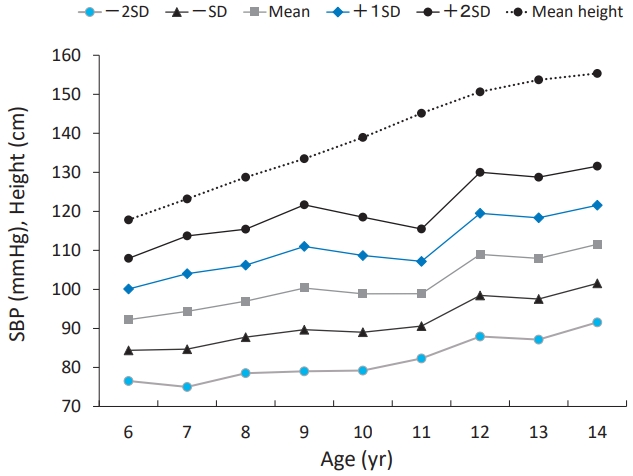
The prevalence of Japanese pediatric hypertension is 0.9% based on proper measurement protocols. Hypertensive children tend to be hypertensive adults. Pediatric essential hypertension is characterized by an absence of symptoms, obesity, a family history of hypertension, and a low birth weight. The most common causes of pediatric secondary hypertension are renal parenchymal and renovascular diseases. Important factors controlling pediatric hypertension include healthy lifestyle modifications and pharmacotherapy.
- Infection
- Epidemiological changes in infectious diseases during the coronavirus disease 2019 pandemic in Korea: a systematic review
- Jong Gyun Ahn
- Clin Exp Pediatr. 2022;65(4):167-171. Published online November 30, 2021
-
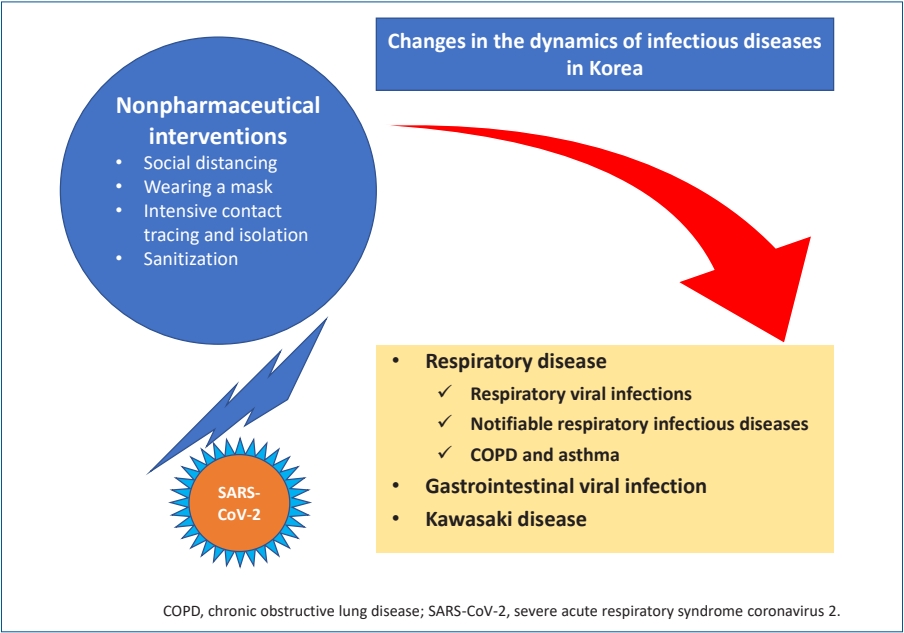
· Nonpharmaceutical interventions (NPIs) have had a major impact on the epidemiology of various infectious diseases in Korea.
· Respiratory diseases and gastrointestinal viral diseases were significantly reduced during the NPI period.
· The decrease in Kawasaki disease after the introduction of NPI is an unintended result.
· Infectious diseases that decreased during NPI use may re-emerge.
· We must continuously monitor the epidemiology of various infectious diseases during the coronavirus era
- Original Article
- Pulmonology
- Modified high-flow nasal cannula for children with respiratory distress
- Sarocha Itdhiamornkulchai, Aroonwan Preutthipan, Jarin Vaewpanich, Nattachai Anantasit
- Clin Exp Pediatr. 2022;65(3):136-141. Published online May 24, 2021
-
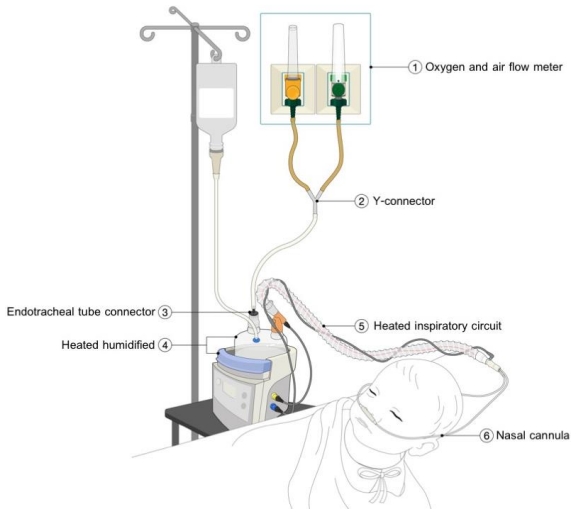
Question: Can the modified high-flow nasal cannula (HFNC) provide alternative respiratory support for children with acute respiratory distress?
Finding: A total of 74 patients were assigned to the modified or commercial HFNC groups. The intubation rate, length of hospital stay, and adverse events did not differ between the 2 groups.
Meaning: The modified HFNC can provide alternative respiratory support for pediatric respiratory distress.
- Neonatology (Perinatology)
- Is fetal nuchal cord associated with autism spectrum disorder? A meta-analysis
- Ensiyeh Jenabi, Maryam Ahmadi, Azam Maleki
- Clin Exp Pediatr. 2022;65(3):131-135. Published online September 24, 2021
-
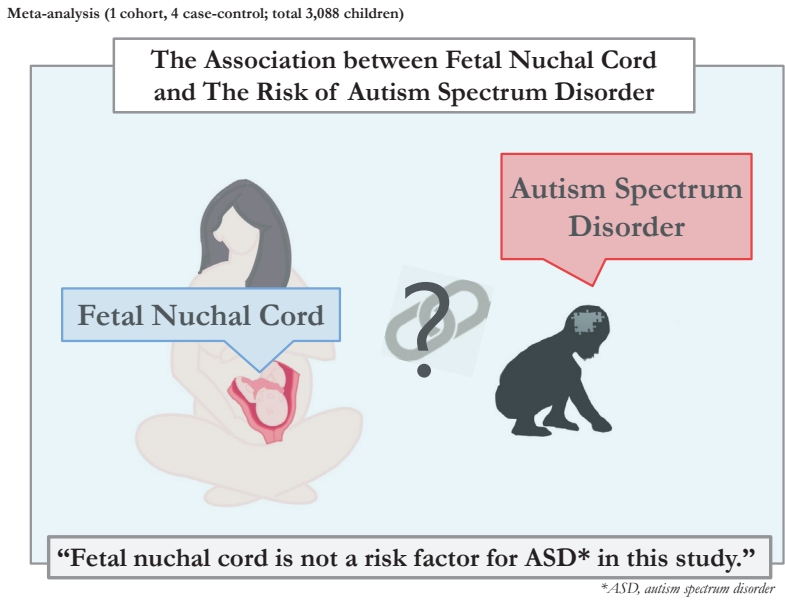
Question: Is fetal nuchal cord a risk factor for autism spectrum disorder (ASD)?
Finding: Five articles (1 cohort, 4 case-control; total 3,088 children) were included in the present meta-analysis. Fetal nuchal cord was not a risk factor for ASD (odds ratio, 1.11; 95% confidence interval, 0.66–1.57). There was homogeneity among studies that reported a risk of ASD (I2=0.0).
Meaning: Fetal nuchal cord is not a risk factor for ASD.
- Developmental and Behavioral Medicine
- Effectiveness of obesity interventions among South Korean children and adolescents and importance of the type of intervention component: a meta-analysis
- Siyoung Choe, Jaesin Sa, Jean-Philippe Chaput, Deokjin Kim
- Clin Exp Pediatr. 2022;65(2):98-107. Published online November 23, 2021
-
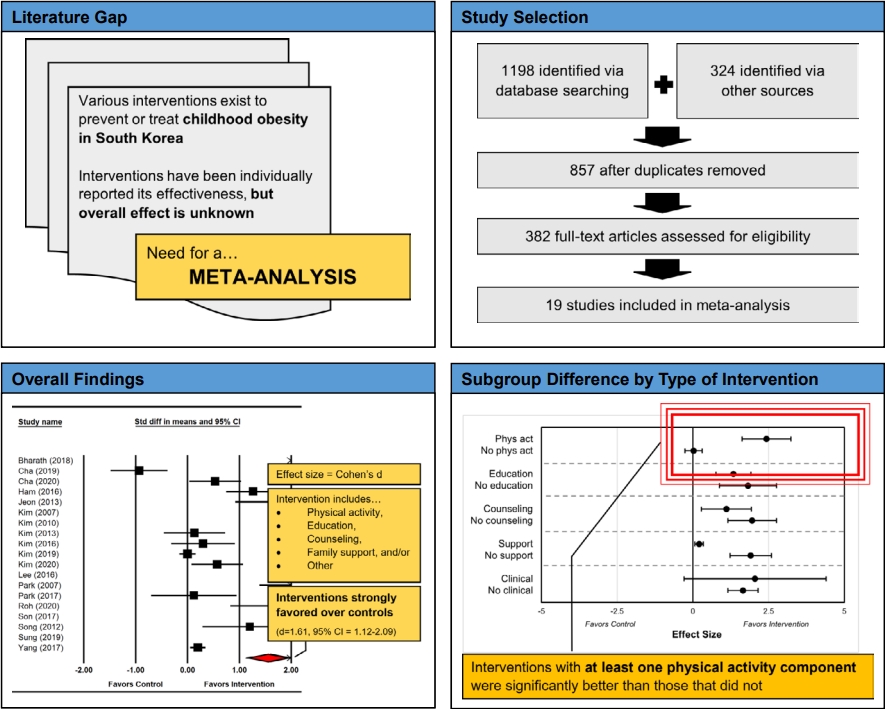
Question: What is the overall effect of obesity interventions among Korean children and what affects their effectiveness?
Finding: Interventions were strongly favored over controls. Interventions including at least one physical activity component were significantly better than those that did not. Sex, age, baseline weight category, intervention duration, and the number of intervention components were not significant.
Meaning: Future obesity interventions for Korean children must seek to include physical activity components.
- Endocrinology
- Association between polycystic ovary syndrome and risk of attention-deficit/hyperactivity disorder in offspring: a meta-analysis
- Azam Maleki, Saeid Bashirian, Ali Reza Soltanian, Ensiyeh Jenabi, Abdollah Farhadinasab
- Clin Exp Pediatr. 2022;65(2):85-89. Published online April 15, 2021
-
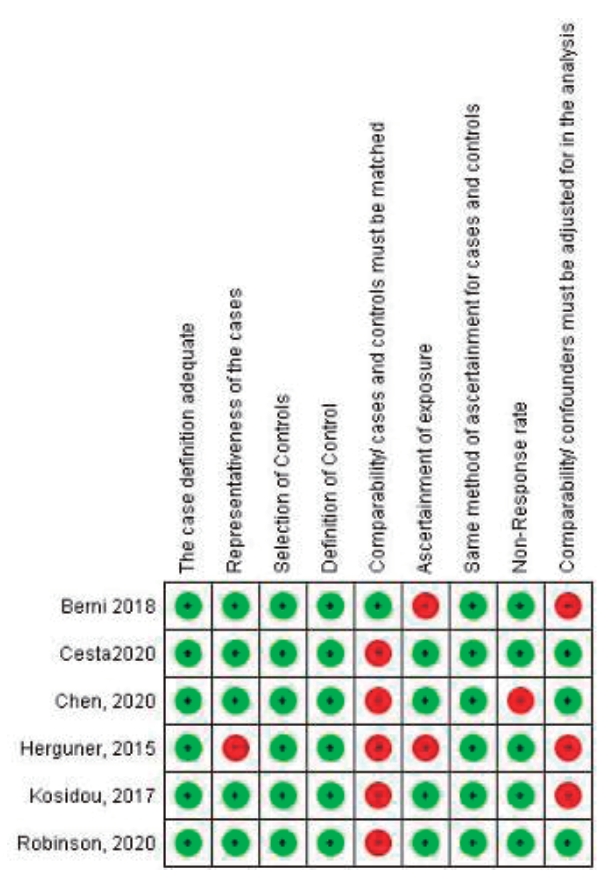
Question: Have polycystic ovary syndrome (PCOS) increased risk of having an offspring with attention-deficit/hyperactivity disorder (ADHD)?
Finding: Six articles (3 cohort and 3 case-control studies; 401,413 total ADHD cases) met the study criteria. Maternal PCOS was associated with an increased risk of ADHD in the offspring based on odds ratio (OR) and relative ratio (RR) (OR, 1.42; 95% confidence interval [CI], 1.27–1.57) and (RR, 1.43; 95% CI, 1.35–1.51), respectively.
Meaning: Our study showed that maternal PCOS is a risk factor for ADHD.
- Neurobehavior
- Association between small for gestational age and risk of autism spectrum disorders: a meta-analysis
- Ensiyeh Jenabi, Saeid Bashirian, Zahra Asali, Mahdieh Seyedi
- Clin Exp Pediatr. 2021;64(10):538-542. Published online January 28, 2021
-

• The relationship between small for gestational age (SGA) and autism spectrum disorders (ASDs) and remains conflicting.
• We showed based on odds ratio reports in epidemiological studies that SGA can increase the risk of ASD and SGA is a risk factor for ASD.
• The association between SGA and the risk of ASD has further momentum to the current public health emphasis on appropriate prepregnancy weight and weight gain during pregnancy
- Is there an association between labor induction and attention-deficit/hyperactivity disorder among children?
- Ensiyeh Jenabi, Mahdieh Seyedi, Saeid Bashirian, Bita Fereidooni
- Clin Exp Pediatr. 2021;64(9):489-493. Published online February 5, 2021
-
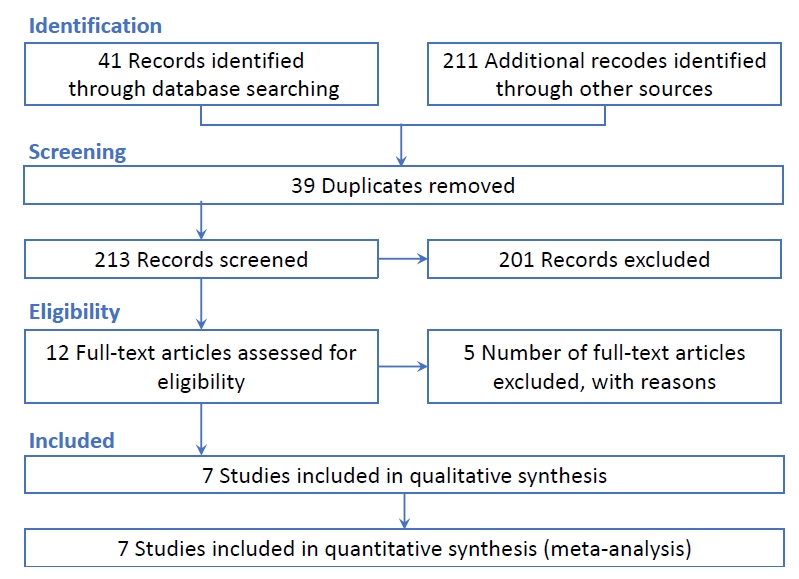
· This meta-analysis pooled all observational (case-control and cohort) studies to obtain the association between labor induction and the risk of attention-deficit/hyperactivity disorder (ADHD) among children.
· The findings showed that labor induction is not associated with increased risk of ADHD among children.
- Allergy
- Cohort profile: National Investigation of Birth Cohort in Korea study 2008 (NICKs-2008)
- Ju Hee Kim, Jung Eun Lee, So Min Shim, Eun Kyo Ha, Dong Keon Yon, Ok Hyang Kim, Ji Hyeon Baek, Hyun Yong Koh, Kyu Young Chae, Seung Won Lee, Man Yong Han
- Clin Exp Pediatr. 2021;64(9):480-488. Published online January 5, 2021
-
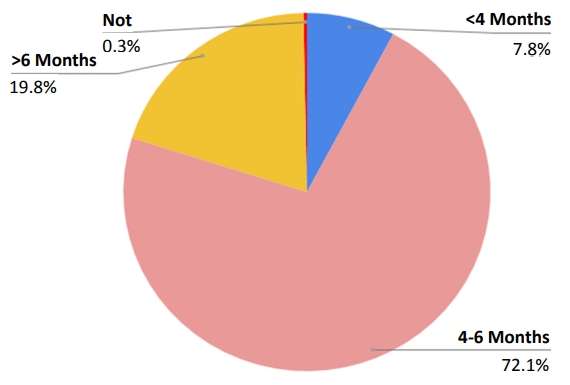
This national cohort study included all Korean children born in 2008 and 2009 observed over a period of more than 10 years. Our findings demonstrate that it is possible to analyze disease onset prior to hospitalization based on information such as lifestyle, eating habits, and risk factors by integrating National Health Insurance System data with national health screening data.
- Review Article
- Nutrition
- Dietary intake and nutritional status of Korean children and adolescents: a review of national survey data
- Minji Kang, So Yoon Choi, Minyoung Jung
- Clin Exp Pediatr. 2021;64(9):443-458. Published online December 28, 2020
-
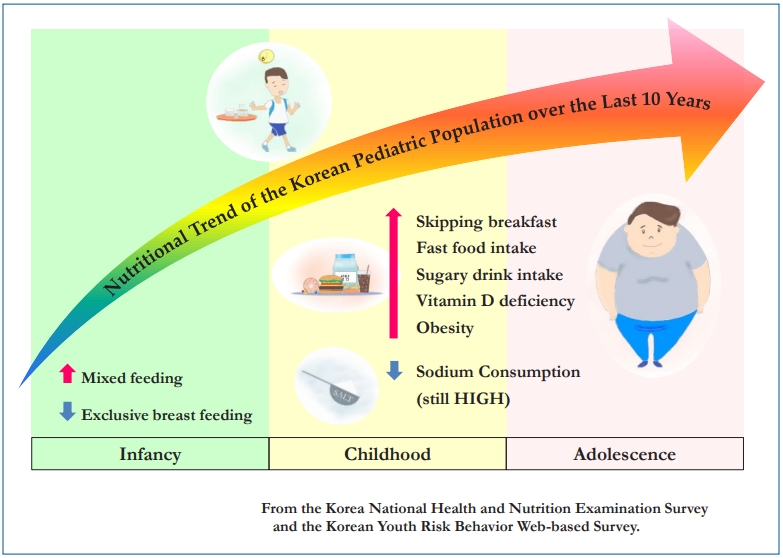
In Korea, several national cross-sectional surveys monitor the diet, nutritional status, and health status of children. This continual dedicated national surveillance system contributes to the identification of nutritional and health issues, establishment of public health policies, and development of nutrition recommendations. This paper provides recent information about the Korea National Health and Nutrition Examination Survey and the Korean Youth Risk...
- Original Article
- Allergy
- Influence of age at complementary food introduction on the development of asthma and atopic dermatitis in Korean children aged 1–3 years
- Jihyun Lee, Meeyong Shin, Bora Lee
- Clin Exp Pediatr. 2021;64(8):408-414. Published online November 1, 2020
-

Question: Is age at the time of complementary food introduction associated with asthma and atopic dermatitis (AD) in early childhood?
Finding: We found no significant association between age at the time of complementary food introduction and the incidence of AD and asthma in Koreans aged 1–3 years.
Meaning: Our findings suggest that the influence of individual allergenic foods on the development of AD and asthma should be clarified.
- Review Article
- Allergy
- Food allergies and food-induced anaphylaxis: role of cofactors
- Meeyong shin
- Clin Exp Pediatr. 2021;64(8):393-399. Published online November 12, 2020
-

Question: What are the roles of cofactors in food allergies and food-induced anaphylaxis?
Finding: Cofactors reportedly play a role in approximately 14%–30% of anaphylactic reactions. Cofactors such as exercise, infection, nonsteroidal anti-inflammatory drugs, dehydration, and alcohol can increase intestinal permeability and antigen uptake, thereby causing allergic symptoms.
Meaning: Routine assessment of the possible involvement of cofactors is essential for the management of patients with food-induced anaphylaxis.
- Neurology
- Is it really a seizure? The challenge of paroxysmal nonepileptic events in young infants
- Seung Yeon Jung, Joon Won Kang
- Clin Exp Pediatr. 2021;64(8):384-392. Published online September 18, 2020
-

Paroxysmal nonepileptic events (PNE) comprise of a variety of nonepileptic behaviors and are divided into various types. A more accurate diagnosis is possible by examining the video clip provided by the caregiver. In infants, physiologic PNE accounts for the majority of the PNE. It is important to exclude epilepsy, for which blood tests, electroencephalography, and imaging tests can facilitate differential...
- Original Article
- Nephrology (Genitourinary)
- Expression profiling of cultured podocytes exposed to nephrotic plasma reveals intrinsic molecular signatures of nephrotic syndrome
- Stuti Panigrahi, Varsha Chhotusing Pardeshi, Karthikeyan Chandrasekaran, Karthik Neelakandan, Hari PS, Anil Vasudevan
- Clin Exp Pediatr. 2021;64(7):355-363. Published online November 1, 2020
-
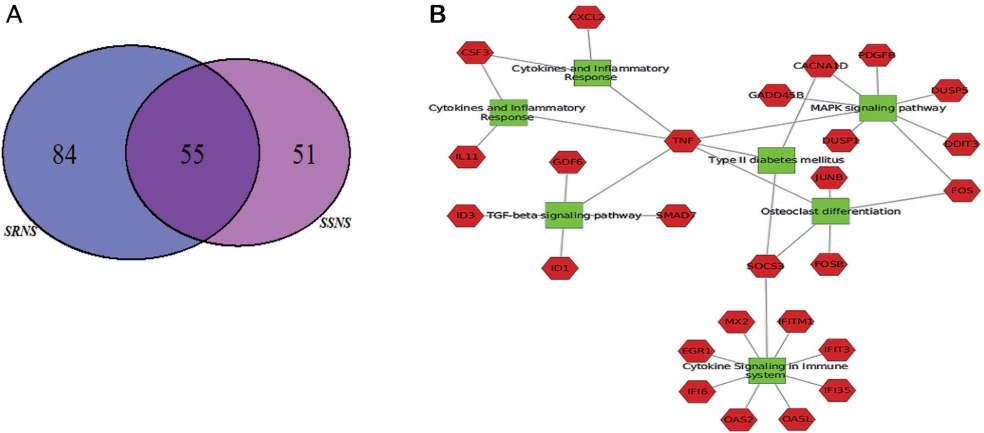
Question: Is it possible to classify nephrotic syndrome (NS) through gene expression profiling of podocytes exposed to NS plasma?
Finding: Our data showed different expression profiles in podocytes exposed to nephrotic plasma from different clinical groups, suggesting the molecular stratification of patients into intrinsic subtypes.
Meaning: Transcriptome profiling of podocytes treated with NS plasma can stratify patients into intrinsic subtypes and provide insight into the molecular mechanisms of podocyte injury.
- Developmental and Behavioral Medicine
- Is meconium exposure associated with autism spectrum disorders in children?
- Ensiyeh Jenabi, Erfan Ayubi, Salman Khazaei, Saeid Bashirian, Mojtaba Khazaei
- Clin Exp Pediatr. 2021;64(7):341-346. Published online October 4, 2020
-
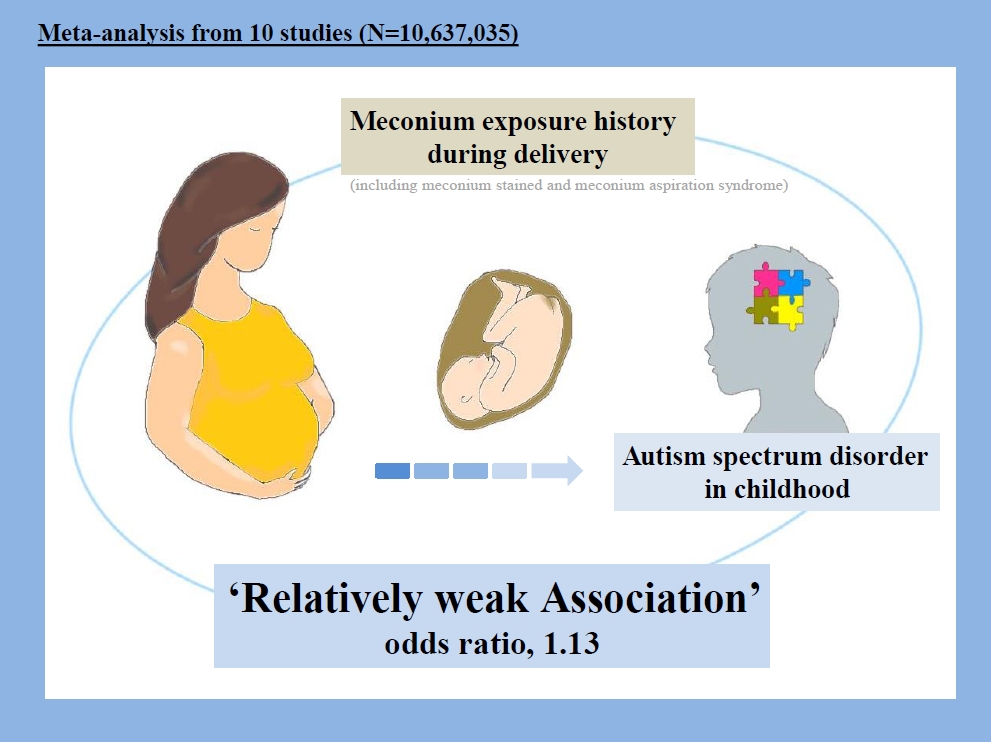
• Meconium exposure is weakly associated with an increased risk of autism spectrum disorder (ASD) development in children.
• More evidence based on large prospective cohort studies is required to conclude whether meconium exposure is associated with an increased risk of ASD.
- Editorial
- Neurology
- Recent trends in autism spectrum disorder research using text mining of PubMed: importance of early detection
- Seung Soo Kim
- Clin Exp Pediatr. 2021;64(7):339-340. Published online November 9, 2020
-
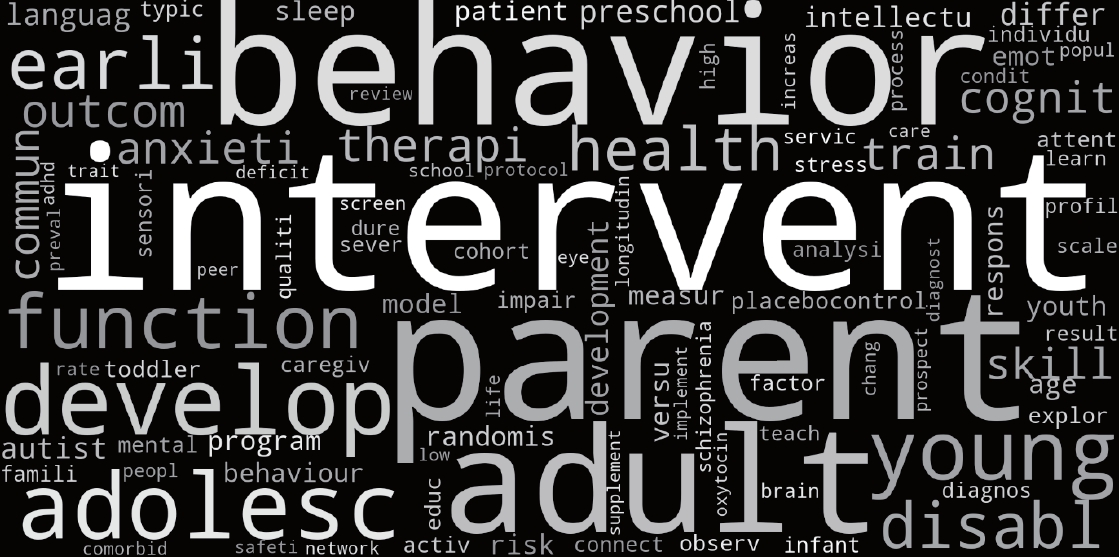
Behavioral therapy, the most widely proven intervention for the core symptoms of autism spectrum disorder (ASD), is required for life for individuals with ASD. Parent involvement, early detection, and early therapy play important roles. We must organize the risk factors for ASD and develop a screening tool that can be easily applied in the clinical, daycare, or school setting.
- Psychogenic nonepileptic seizures; beyond differentiating from epileptic seizures
- Sang Ook Nam
- Clin Exp Pediatr. 2021;64(6):282-283. Published online November 12, 2020
-
- Review Article
- Cardiology
- Application of CRISPR-Cas9 gene editing for congenital heart disease
- Heeyoung Seok, Rui Deng, Douglas B. Cowan, Da-Zhi Wang
- Clin Exp Pediatr. 2021;64(6):269-279. Published online March 2, 2021
-
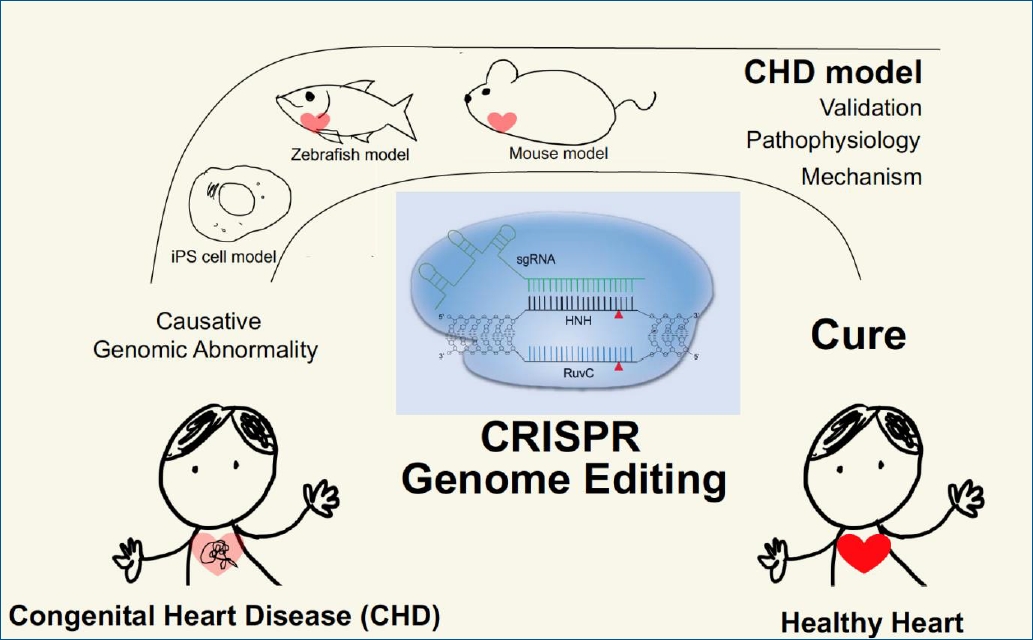
Clustered regularly interspaced short palindromic repeats and CRISPR-associated protein 9 (CRISPR-Cas9) system has made a big step in the genome editing which still requires technical developments for the efficient applications in the many fields including congenital heart diseases (CHDs), closely related to the genomic abnormality. In this review, we tried to cover the most updated researches of CRISPR-Cas9 in the CHDs to understand the current technologies, eventually becoming therapeutic bases for the CHD patients.
- Neurology
- Myths and truths about pediatric psychogenic nonepileptic seizures
- Jung Sook Yeom, Heather Bernard, Sookyong Koh
- Clin Exp Pediatr. 2021;64(6):251-259. Published online October 17, 2020
-
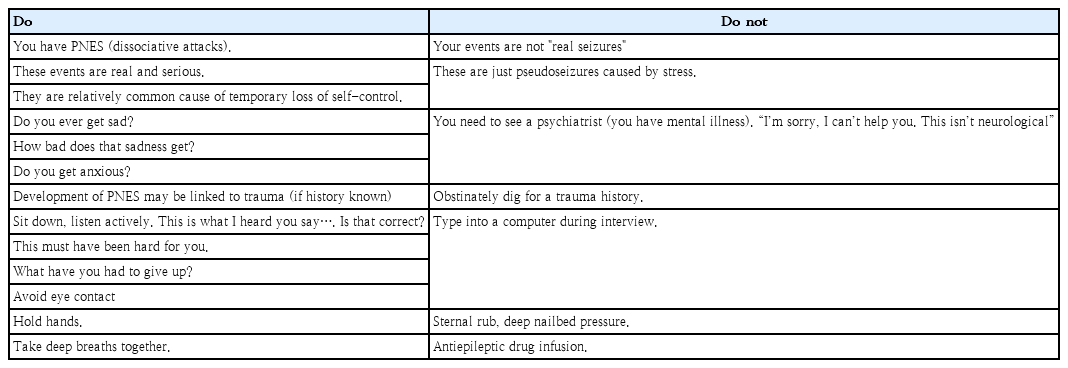
• Psychogenic non-epileptic seizures (PNES) are events that look like epileptic seizures but are not caused by abnormal electrical discharges.
• PNES are a manifestation of psychological and emotional distress.
• Treatment for PNES does not begin with the psychological intervention but starts with the diagnosis and how the diagnosis is delivered.
• A multifactorial biopsychosocial process and a neurobiological review are both essential components when treating PNES
- Genetics and Metabolism
- Understanding the genetics of systemic lupus erythematosus using Bayesian statistics and gene network analysis
- Seoung Wan Nam, Kwang Seob Lee, Jae Won Yang, Younhee Ko, Michael Eisenhut, Keum Hwa Lee, Jae Il Shin, Andreas Kronbichler
- Clin Exp Pediatr. 2021;64(5):208-222. Published online July 15, 2020
-

Bayesian false-discovery probability and false-positive report probability are the 2 major Bayesian methods used to evaluate noteworthiness of a genetic variant.
Application of stricter P value is needed to confirm statistical significance in meta-analyses.
Gene network analysis of noteworthy genetic variants shows a blueprint of the genetic background in complex diseases.
- Critical Care Medicine
- The use of extracorporeal membrane oxygenation in children with acute fulminant myocarditis
- Silver Heinsar, Sainath Raman, Jacky Y. Suen, Hwa Jin Cho, John F. Fraser
- Clin Exp Pediatr. 2021;64(5):188-195. Published online August 10, 2020
-
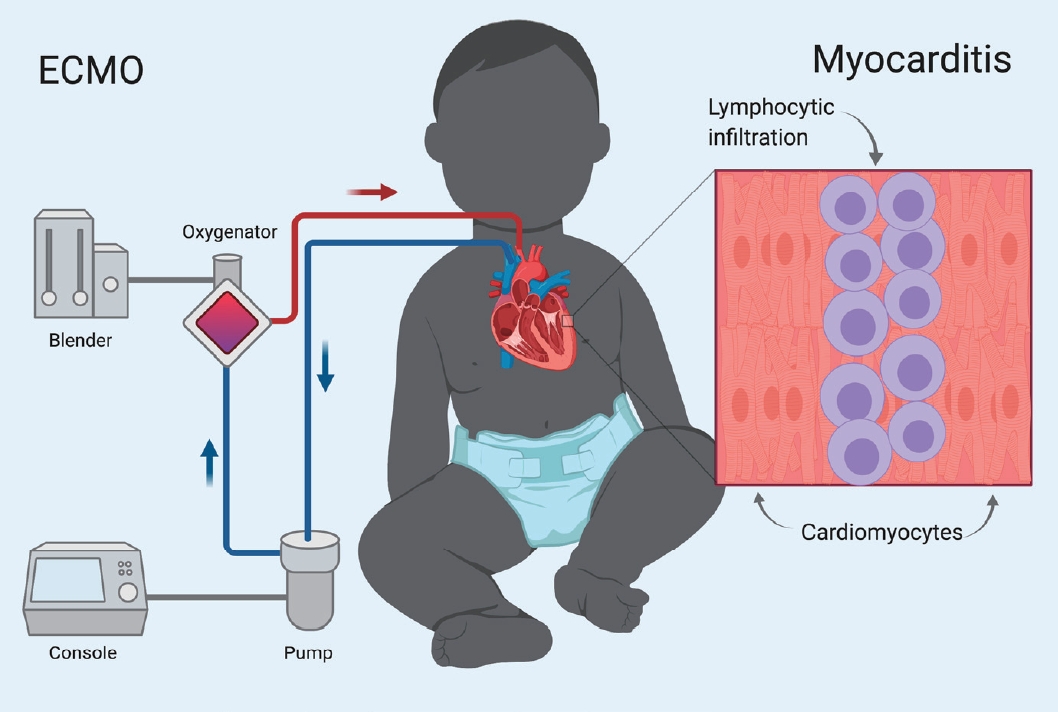
Acute fulminant myocarditis (AFM) occurs as an inflammatory response to an initial myocardial insult. Its rapid and deadly progression calls for prompt diagnosis with aggressive treatment measures. The demonstration of its excellent recovery potential has led to increasing use of mechanical circulatory support, especially extracorporeal membrane oxygenation (ECMO). Arrhythmias, organ failure, elevated cardiac biomarkers, and decreased ventricular function at presentation...
- Genetics and Metabolism
- Neurofibromatosis type I: points to be considered by general pediatricians
- Eungu Kang, Hee Mang Yoon, Beom Hee Lee
- Clin Exp Pediatr. 2021;64(4):149-156. Published online July 15, 2020
-
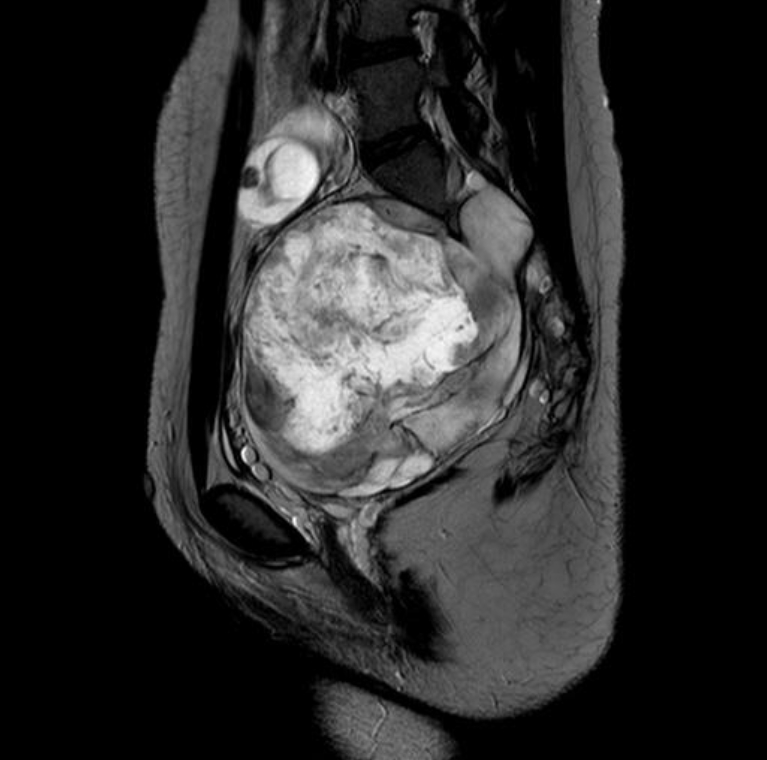
Neurofibromatosis type 1 (NF1), a prevalent genetic disease that is transmitted in an autosomal dominant manner, is characterized by multiple cutaneous café-au-lait spots and neurofibromas as well as various degrees of neurological, skeletal, and neoplastic manifestations. The clinical features of NF1 increase in frequency with age, while the clinical diagnosis can remain undetermined in some pediatric patients. Importantly, affected patients...
-

-
-
6.02024CiteScore98th percentilePowered by
-
Impact Factor3.6
-
- TOPICS
- ARTICLE CATEGORY
- Editorial Office
-
Korean Pediatric Society
#1606 Seocho World Officetel, 19 Seoun-ro, Seocho-ku, Seoul 06732, Korea
Tel: +82-2-3473-7306 Fax: +82-2-3473-7307 E-mail: office@e-cep.org
Clinical and Experimental Pediatrics is an open access journal. All articles are distributed under the terms of the Creative Commons Attribution NonCommercial License (http://creativecommons.org/licenses/by-nc/4.0/)
Copyright © 2025 by Korean Pediatric Society.











